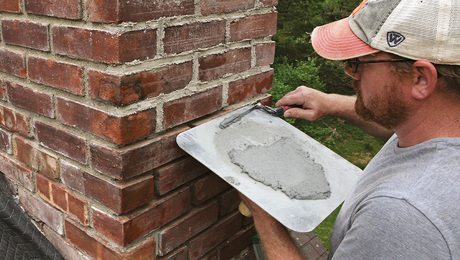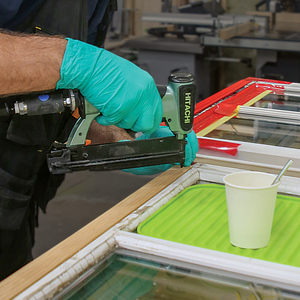Anyone got a tip on how to avoid becoming Popeye the sailor when installing grout? I finished 700 foot of 1/4 inch sanded grout lines on the floor (yep Boris, I sealed with the gold 15) and now I started into the wall tiles (4 1/4 inch ceramic standards with unsanded grout. We did about 400 Sq foot of that.
The unsanded wall joints are every bit as tough to finish properly as the sanded floor joints were. I have to be missing something. I use the Latex admixture. mix it to peanut butter consistency, use the rubber trowel to push it in the 1/8 inch wall joints, and then sponge off the excess. Finally I take the scrubbie side and tailor the joints to look nice. By the time I’m done I feel like I’ve got Popeye’s arms.
Is there an easier way? Is thinner grout a better choice? Am I whining too much. Is there a machine? I don’t mean to be a weenie here but there is no letup when you mix up this stuff. It has a 20 minute window of being applicable. after that you can see the material start to set-up. It gets to be a breathless race like eating really hot mexican food.
I’ve got 150 sq ft of 2×2 to grout next (again 1/8″ joints on the floor including the shower floor). Sanded again or unsanded? I could use some tips for this cabin in the north. I’d hate to die on a partially finished tile floor.
Ark Arkg Arkgg.



















Replies
there are machines to make this work easier....
they're called....Professional Tile Installers.
Sometimes..they're called Remodelers....like my model ID.
Haven't ya figured this out yet...this type of work is...uh...what's the word......Oh yeah....HARD! Stuff's heavy....working conditions can be too hot or too cold....and from what I've seen......almost nothing in a house comes preassembled!
It's almost like ya gotta build the damn thing from scratch.
Look on the bright side....after ya master the tile...you'll be able to impress the neighborhood chicks with great feats of superhuman strength.
Like my old boss...many many years ago...used to say when we were pouring concrete......Most people pay good money for a work out like this! He's letting us excercise for free......
Jeff
Buck Construction Pittsburgh,PA
Fine Carpentery.....While U Waite
Whaddyabitchinabout? Your knees didn't lock up & you can still stand up straight? Grout sucks, no way around it. Sucks worse if you let it set up on the tile. Joe H
Back when i was doing tile all the time, I hired an indian girl with arms as big as my legs. She loved the work, and the pay!
Excellence is its own reward!
So she looked like OliveOil?
eat your spinach and acquire a grout bag. you can shoot the lines a wall at a time, and tool the joints on your break.
I had one of those grout bags in my hands and wondered if it was worth the trouble. Don't you have to tool the grout anyway and still push the excess? Sure doesn't seem like much of an improvement sort of like a paint sprayer. I painted faster but the time I saved was spent cleaning up the equipment.
This grout stuff sure seemed like it would be pansy stuff. To get it in the grooves deeply and have a nice raked finish you really have to power it on. That alone is probably the reason the Abitibi vinyl covered masonite took off so fast as a bathroom wall surface.
I'm thinking I ought to mix smaller batches next time. 5 lbs at a crack is too much to spread without stopping for a coffee or a beer.
One further question is how soupy can you go? Obviously it would pool at your shoes if you got stupid with the Admixture but what is the tell tale sign of it being too thin? Does it go to pot like concrete that is too wet?
Glad I could amuse you all. I can't tell you how sharp it does look. This is that cheap white ceramic 4" sq lining the bathroom walls over a Porcelain slate tile floor. Harvest grout (deep brown on the floor) and chocolate brown in between the white tile. The sharp contrast of the chocolate & white would make a bad job evident. Gotta bring a camera and then scan some in.Jack of all trades and master of none - you got a problem with that?
what kind of grout/admixture are you using? I prefer Mapei with the dry-mix additive, so that it's just-add-water. Less fooling around. I can usually get 2-3 hours out of a bucket, which is enough to get a whole tub surround done. The art of the process is timing- spreading it all in there can be done fairly quickly, but efficient clean up requires good timing, as you want the grout to be stiff enough that it won't pull out of the joints you just filled, but not too dry that you can't get the haze off.
In a typical tub surround I'll work in 3x3 or 3x4 sections, waiting about 10-15 minutes between when I first pack the grout in and my first cleanup pass with the float. I am by no means fast compared to some of the professionals I've seen, but it moves along quickly enough. Just remember not to get in over your head and try to do too much at once.. you're better off mixing smaller buckets and taking your time.
Boy it is hard to say as the containers are 2 hours away from me right now. I suppose it is Superior brand as that was the same brand they had for sanded grout. The admixture was a latex liquid from the same store.
In 20 minutes the mixed material starts to take a set, in 30 to 40 minutes it noticably curdles. I think before that point I ought to pitch the remainder as I'm probably not getting the best cross-linking or whatever unites the grout particles.
I think the 5 LB batch I originally made was a bit optimistic. I think 1/2 of that would be more managable.
I just wonder if a thinner peanut butter consistency would be a better application thickness.
Jack of all trades and master of none - you got a problem with that?
Booch, relax, breath deep, remember it's fun, and best of all, it's got your name written all over it. So when your lower back is tighening up, shoulder's are creaking, elbow just plain wore out, and your all cleaned up and ready to go home, because your earned it, Hang on, for you still got to clean those bucket's, and then, go over all that tile once more with a terry clothe towel, paying close attention to those edges and corners. I think I'am going to like your pictures, Jim J., p.s. don't wipe with the towel until everything is dry.
The Terry cloth towel is a step I miss. I have been using a drier and drier sponge each stage. At probably the 5th or 6th pass is where I lay on the floor and review the work. Nice grout lines at the floor by the way.
I have also gotten the colored silicone caulk that matches the grout. It took til Tuesday's morning shower to get the last of that stuff off of my fingerprints. I put it as the adhesive that holds in the soap & grabs, towel bars, & TP holder. Each of those accessories get adhered in the cutout tile area with the caulk and then after tooled it is supported with duct tape so gravity doesn't undo my work.
The real time consumer is the corners of the room. Where a wall meets another I put in the silicone caulk and finger tool it into the corner. I wipe away the excess using the finger as a squeege and wipe the finger on a paper towel. The floor gets the same treatment.Jack of all trades and master of none - you got a problem with that?
Carbide bits in the rotozip? I've burned 2, snapped off 1, and I think the tool is on the way out. I saw a TOH episode last week where our hero uses the same tool but has the artist homeowner spray the bit as he is cutting the tile and wallboard at the same time. I concur that does work to preserve the bit. So I think that is a good method to save the bits.
As for the tool itself. I've already cracked that case open once and taken out a bunch of caked DW dust. The tool is running screwy again and it appears I have to do the same thing all over again. ( I think they must assemble these in zero gravity the way parts fall out) What is with the design on the tool? It seems to suck in the crud and deposit it in crevaces in side the tool. Now I did cut 22 ceiling cans in place and 130 handy boxes in the wall but... That is what it is made for isn't it?
Final thought on that tool. A new one I saw at HD has some sliding grey plastic gate on the air vent near the bit. What is that all about?Jack of all trades and master of none - you got a problem with that?
try wiping down each tile with the terry cloth rag, before you wipe it clean with wet sponges. stay off the grout lines with towel. shop vac the dust up then wipe clean tiles and grout lines with wet sponge and clean water. cuts clean up time in half. mix only the amount of grout your able to handle. I usually mix 1/2 or less 5 gal. pail. depending on job. by the time I finish the pail the area that I first started on has sufficiently dried enough to wipe with terry cloth rags, proceed wipe down field with rag, shop vac dust, start back at beginning with clean water and sponges.
The only thing I can offer is to be sure to stand on something secure while you're working up high - so you don't have to work over shoulder height. That saves some strain on the shoulders and back.
Walls are bad enough - how does anybody grout a tiled ceiling?
"A completed home is a listed home."
on a ceiling, the grout bag really works. if your tip is cut just narrow enough, and you force the mix so it sticks in the joints, it won't fall out. the funny thing is that those cheap throw away bags ($3) seem to work better for me than my expensive marshalltown bag.
Easier said than done. I've got a 9' wall in the tub surround. It goes all the way to the ceiling. I've got a shortie step ladder to ease the effort, plus the eyes don't see as well that far away so it won't be as critical. It just has to be functional.Jack of all trades and master of none - you got a problem with that?
Barwalt Grout System. Extra large plastic backed slotted grout sponges that pick up grout residue, but not the grout in the joints and with one swipe dumps the excess grout in a bucket of water. The cost is about $100, but will double your grouting efficiency. Your hands never touch water. Ahhhh the civilized way to grout.
http://www.barwalt.com/form/default.html
This is a toy shop for the rest of us tile guys.
Boris
"Sir, I may be drunk, but you're crazy, and I'll be sober tomorrow" -- WC Fields, "Its a Gift" 1927
Nice tool! (speaking of the sponge thing)
That is one of the worst features of that tile work is the abused skin. Between picking thinset (slopped over tile already set) and dipping in the bucket every minute you can really get some dry skin.
That thing seems to meet the need. I've got to go over your link another time to fully understand it. You'd need something like that in order to work on tile full time. Otherwise you'd look like a house maid with hands in rubber gloves.
I still haven't found any gloves large enough to wear regularily. Time to hit the medical supply house. The ones at Rockler were still too tight even in extra large.
Thanks for the tip. 100 bucks? wow. For a pro that would make sense but a guy like me finds the $ dear for that.
Speaking as a cheap s::: I wonder how stiff is the sponge? How often and deep are the grooves? Could I do it on a table saw? A little contact adhesive on a rubber float with some rollers to provide a rolling pressure plate could make a short term solution.
Jack of all trades and master of none - you got a problem with that?
Edited 1/21/2003 9:04:48 PM ET by Booch
In my experience the key to cleaning grout up is to go slowwwwww with the sponge... my first pass with the float to get the excess off is usually across the tile diagonally (I repeat the opposite direction, forming an X pattern). Once substantially all the excess is off, I let it sit for about 10-15 minutes, then do a slow pass with the sponge, rinsing it frequently and trying to keep it as dry as possible. After that I touch up the joints, then usually only need one last pass with the sponge, again- taking it very slow. Maybe 5 seconds per linear foot. If any haze is left I repeat with as dry a sponge as possible, going even slower. Result is perfectly clean, no haze. This works best with porcelain or ceramic- still use a grout bag with stone and other porous tile.
Regarding tooling caulk... seems everyone has their own method, but I use scraps of thin plastic (like 1-2 mil) pulled tight over my finger, to keep the "touch" while avoiding the mess. I do mask everything though which is time consuming.
And yes, I also wear bright orange rubber gloves while grouting...
This is a toy shop for the rest of us tile guys.
mmmmmmmmmmm.......
Thanks for the link!! (there goes another paycheck....)
So over 700 sq feet, how much Gold 15 did you use?
I change out grout frequently. While thinset may last 3 hours or so in the bucket, grout cures quicker. About every 45 minutes or so.
On ceilings, yes mix up a special batch and mix it thick.
Good Luck.
Boris
"Sir, I may be drunk, but you're crazy, and I'll be sober tomorrow" -- WC Fields, "Its a Gift" 1927
A little over a quart. That was one coat with the little dribble bottle and the wheel. The bottle was worth the money (1.50) but not much more. That was one of the easiest efforts so far.
I think the smaller batches of grout will be better to run with. I had the #2 son mixing so I was happy for the help I got and if he wanted to mix a 5 lb bucket I wasn't going to complain. Next load we'll do 1/2 that much for the remaining wall space.
Next up is the Master Bath floor. 150 sq ft of those 2x2 buggers. Again these are 1/8 inch joints. Would you use sanded? I'm thinking regular unsanded would fill the need but I don't know if the floor action requires sand for abrasion resistance.
ThanksJack of all trades and master of none - you got a problem with that?